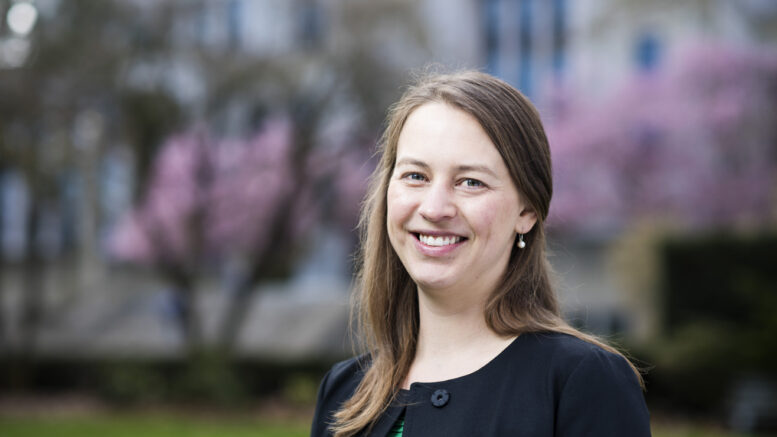 Katie McPherson, who grew up in Napanee, is Vancouver's chief resilience officer, playing a major role in the city's response to COVID-19. Submitted photo.
Katie McPherson, who grew up in Napanee, is Vancouver's chief resilience officer, playing a major role in the city's response to COVID-19. Submitted photo.
April 19, 2020
Adam Prudhomme
Editor
When the COVID-19 pandemic hit Vancouver, B.C., it was up to Katie McPherson to make sure the city’s most vulnerable were kept safe.
The Napanee native, who serves as resilience officer for Canada’s third largest city, is at the forefront of the pandemic response.
“As part of the city’s response to COVID-19, I have been tasked to co-lead a Community Resilience Task Force – with a primary focus on the Downtown Eastside,” said McPherson. “I am working with a phenomenal team of people to prevent the transmission of COVID-19, and also to respond and mitigate the consequences of the loss of services. For example, my team is working to provide food delivery services for people who are in isolation and to create new shelter spaces for people who are homeless or precariously housed.”
McPherson has held her current role for the last three years. Prior to that she worked to help develop the city’s Resilience Strategy with the intent to prepare, adapt and thrive in the face of shocks such as earthquakes and pandemics or stresses such as homelessness and poverty. Prior to that, she was manager of emergency planning.
McPherson says the spread of the virus across the major metropolis has agitated already existing problems.
“I would say there are two major challenges,” she said of responding to the virus outbreak. “The first is the fact that this pandemic is exacerbating the challenges our city was already facing. Vancouver was already in the middle of an opioid crisis and a housing affordability crisis, meaning there was already serious pressure on essential services and non-profit. The need for physical distancing combined with staffing shortages have made it difficult for many non-profits and essential service providers to continue to operate at a time when there is increased demand for low-cost meals, housing and health services. So we are working hard to provide support for frontline workers and to help non-profit and social services to keep their doors open. The second is the nature of the crisis – pandemics are different from other disasters because we are unable to work in physical proximity to other people. Everything takes longer when you need to work virtually and the need to be hyper-vigilant about health means that many services we would normally offer, like community food programs, need to be re-imagined. When you can’t work with people in person, it’s really difficult to act quickly. But we are learning and we are transforming our own operations as we go to become more virtual.”
To support the most vulnerable, the city has developed a Community Stewardship Program in the downtown and has staff working to translate and share information for those living on the street. They are working with healthcare providers to make sure those in need get prescriptions delivered to their home, as well as food and cleaning supplies to more than 1,500 people living in single resident occupancy hotels so they can self-isolate. Recently the city secured a donation of culturally appropriate food for the city’s large Chinese senior population and continues to host a series of town halls in a variety of languages.
Going forward, McPherson expects more disaster responses will be done virtually. Even before COVID-19, the city was starting to develop systems to respond to disasters such as earthquakes that cause blockages to major infrastructure.
“I expect we will also see a much greater emphasis put on emergency response planning and support for social service providers, as well as a lot more collaboration between different service providers for cross-training of staff to provide frontline support,” said McPherson. “Many of the plans we are implementing today, from standing up new shelters to offering food delivery, will all help us to be better prepared for future crises, no matter what they are.”
The crisis is far from over but McPherson says they are on the right path and credits Dr. Bonnie Henry, B.C.’s health officer, for helping to stem the growth of B.C’s numbers after the province was among the hardest hit when the virus was first reported in Canada.
Though she now lives some 4,600 km away on the other side of the country, she credits her upbringing for helping shape her career path.
“I strongly believe that the way we treat each other day-to-day is an indication of how we will react in emergency situations,” said McPherson. “Napanee is a place with a really strong community, where people are always willing to help out their neighbours. I remember during the ice storm of 1998, everyone coming together to make sure people were safe and healthy, and every winter knowing that neighbours are there to help plough roads and shovel walks. People in Napanee don’t turn their backs on their neighbours, and they don’t need to be asked to help out. These lessons have stuck with me – I feel privileged to call Napanee home.”
 Katie McPherson, who grew up in Napanee, is Vancouver's chief resilience officer, playing a major role in the city's response to COVID-19. Submitted photo.
Katie McPherson, who grew up in Napanee, is Vancouver's chief resilience officer, playing a major role in the city's response to COVID-19. Submitted photo.
 Katie McPherson, who grew up in Napanee, is Vancouver's chief resilience officer, playing a major role in the city's response to COVID-19. Submitted photo.
Katie McPherson, who grew up in Napanee, is Vancouver's chief resilience officer, playing a major role in the city's response to COVID-19. Submitted photo.